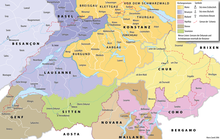Diocese of Como
| Diocese of Como | |
| Basic data | |
|---|---|
| Country | Italy |
| Church region | Lombardy |
| Ecclesiastical province | Milan |
| Metropolitan bishopric | Archdiocese of Milan |
| Diocesan bishop | Oscar Cantoni |
| Emeritus diocesan bishop | Diego Coletti |
| founding | 4th century |
| surface | 4,214 km² |
| Parishes | 338 (2016 / AP 2017 ) |
| Residents | 535,000 (2016 / AP 2017 ) |
| Catholics | 516,891 (2016 / AP 2017 ) |
| proportion of | 96.6% |
| Diocesan priest | 388 (2016 / AP 2017 ) |
| Religious priest | 139 (2016 / AP 2017 ) |
| Catholics per priest | 981 |
| Permanent deacons | 12 (2016 / AP 2017 ) |
| Friars | 172 (2016 / AP 2017 ) |
| Religious sisters | 540 (2016 / AP 2017 ) |
| rite | Roman rite |
| Liturgical language | Italian |
| cathedral | Santa Maria Assunta in Como |
| address | Vescovado Piazza Grimoldi 5 22100 Como Italia |
| Website | www2.chiesacattolica.it |
| Ecclesiastical province | |

|
|
The Diocese of Como ( Latin Dioecesis Comensis , Italian Diocesi di Como ) is a diocese of the Roman Catholic Church in Italy with its seat in Como .
As a suffragan, it is subordinate to the Archdiocese of Milan . The Cathedral of Como serves as the cathedral . The diocese was founded in the 4th century.
history
The diocese of Como was founded in 386 by Bishop Ambrosius of Milan . The first bishop was Saint Felix, who made a contribution to the Christianization of Comos and Valtellina. That is why Milan is the mother church of Comos. Local legends assign the Christianization of Comos to Saint Hermagoras of Aquileia .
Originally the Diocese of Como was under the Archdiocese of Milan . Throughout the early Middle Ages, the relationship between the two dioceses was marked by tensions that led to the separation of Comos from Milan between 606 and 608 on the occasion of the three-chapter dispute . Subsequently, Como submitted to the Patriarchate of Aquileia and therefore kept the ritus patriarchinus of Aquileia until 1598 . Since then Como has followed the Roman rite.
During the early Middle Ages, the bishops of Como acquired numerous secular privileges, sovereign rights and regalia from the rulers of the Holy Roman Empire . In the 10th century, the bishops of Como therefore exercised secular power in a large part of their diocese. However, the city of Como emancipated itself from the rule of bishops as early as the 11th century. From 1355 the territory of Como was under the Duchy of Milan . After the conquest of Valtellina , Chiavennas and Bormios by the Three Leagues , the invasion of the Reformation in the Graubünden area caused violent disputes between the denominations, which led to the turmoil of the Graubünden after the murder of the Catholic archpriest of Sondrio, Nicolò Rusca . While the Reformation was practically reversed for the Graubünden subject areas through the Veltliner murder and the Counter Reformation , Reformed parishes remained in the parishes of Poschiavo and Brusio .
The old borders of the Diocese of Como showed a complicated and irregular course, especially in today's Canton of Ticino . The Sottoceneri (with the exception of Capriasca and Campione ) as well as Locarno and Bellinzona belonged to Como, the so-called Ambrosian valleys to Milan. Since 1884 the Swiss parts of the diocese in Ticino, together with the areas formerly subordinate to Milan, form the diocese of Lugano . The Graubünden valleys of Bergell and Poschiavo also originally belonged to Como. The former went to the diocese of Chur in the 10th century, not without conflicts , the latter was transferred to the diocese of Chur by mutual agreement in 1869/70.
In 1528 Como was withdrawn from the Patriarchate of Aquileia and returned to the Archdiocese of Milan. After Milan came to Austria, the Emperor assigned Como to the Archdiocese of Gorizia for a short time in 1751 . Como has been under Milan again since 1807.
Numerous bishops of Milan were canonized. St. Probinus (391); St. Amantius (420); St. Abundius (450), papal legate at the Council of Chalcedon ; St. Consul (469); St. Exuperantius (495); St. Eusebius (512); St. Eutychius (525); St. Euplius (532); St. Flavianus (535); St. Prosper (560); St. John Orcus (565); St. Agrippinus (568); St. Rubianus (586); St. Martinianus (615); St. Victorinus (628), fighter of Arianism among the Lombards etc.
Important bishops were Albericus (1010), founder of the Abbey of St. Abondio; Rainald (1061), who was banished by Henry IV because of his loyalty to Pope Gregory VII ; Wilhelm della Torre (1204), builder of numerous important churches; Lucchino Borsano (1396), who initiated the rebuilding of the Como Cathedral.
See also
Web links


